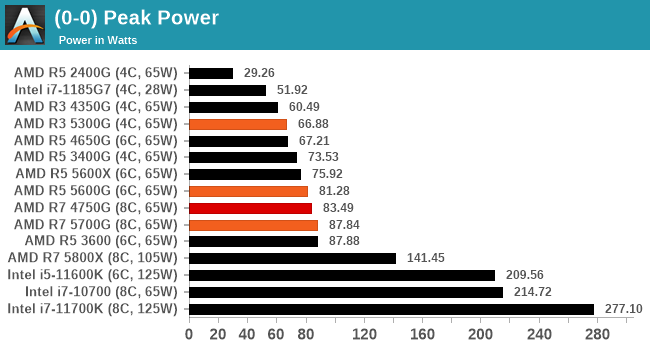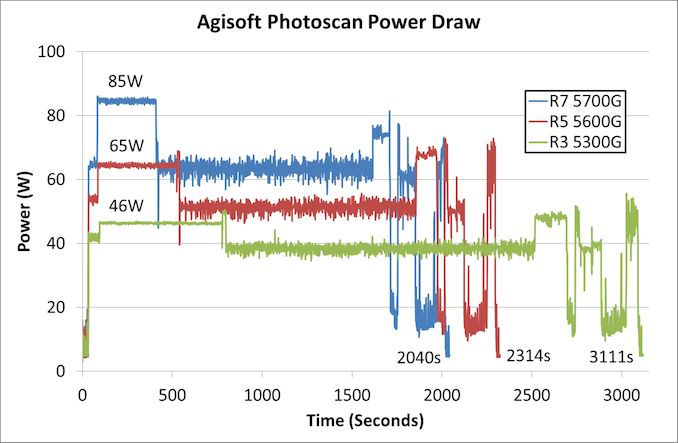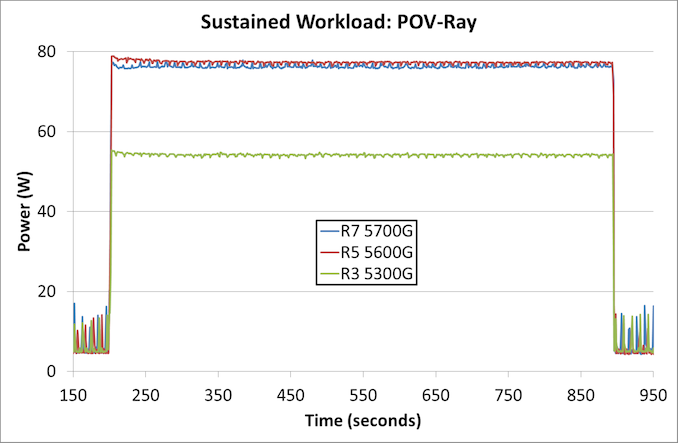The AMD Ryzen 7 5700G, Ryzen 5 5600G, and Ryzen 3 5300G Review
by Dr. Ian Cutress on August 4, 2021 1:45 PM ESTPower Consumption
The nature of reporting processor power consumption has become, in part, a dystopian nightmare. Historically the peak power consumption of a processor, as purchased, is given by its Thermal Design Power (TDP, or PL1). For many markets, such as embedded processors, that value of TDP still signifies the peak power consumption. For the processors we test at AnandTech, either desktop, notebook, or enterprise, this is not always the case.
Modern high-performance processors implement a feature called Turbo. This allows, usually for a limited time, a processor to go beyond its rated frequency. Exactly how far the processor goes depends on a few factors, such as the Turbo Power Limit (PL2), whether the peak frequency is hardcoded, the thermals, and the power delivery. Turbo can sometimes be very aggressive, allowing power values 2.5x above the rated TDP.
AMD and Intel have different definitions for TDP, but are broadly speaking applied the same. The difference comes to turbo modes, turbo limits, turbo budgets, and how the processors manage that power balance. These topics are 10000-12000 word articles in their own right, and we’ve got a few articles worth reading on the topic.
- Why Intel Processors Draw More Power Than Expected: TDP and Turbo Explained
- Talking TDP, Turbo and Overclocking: An Interview with Intel Fellow Guy Therien
- Reaching for Turbo: Aligning Perception with AMD’s Frequency Metrics
- Intel’s TDP Shenanigans Hurts Everyone
In simple terms, processor manufacturers only ever guarantee two values that are tied together - when all cores are running at base frequency, the processor should be running at or below the TDP rating. All turbo modes and power modes above that are not covered by warranty. Intel kind of screwed this up with the Tiger Lake launch in September 2020, by refusing to define a TDP rating for its new processors, instead of going for a range. Obfuscation like this is a frustrating endeavor for press and end-users alike.
However, for our tests in this review, we measure the power consumption of the processor in a variety of different scenarios. These include workflows, real-world image-model construction, and others as appropriate. These tests are done as comparative models. We also note the peak power recorded in any of our tests.
First up is our image-model construction workload, using our Agisoft Photoscan benchmark. This test has a number of different areas that involve single thread, multi-thread, or memory limited algorithms.
For the Ryzen 7 5700G, the most power-hungry part of the test is right at the beginning, where we’re seeing peaks of 85 W. For the 5600G, that first section goes to 65 W, but the peaks actually occur here near the end of the test. The 5300G also has peaks later in the test, but that first section is the lowest, running only at 46 W.
The second test is a sustained rendering workload.
In this instance, the Ryzen 3 5300G is nearer 55 W with a sustained workload over 10 minutes, while the Ryzen 5 and Ryzen 7 sit just below 80 W.
For peak power, we report the highest value observed from any of our benchmark tests.

While all three processors have a TDP rating of 65 W, by default on AMD systems the Package Power Tracking, which is the limiting factor here, is 88 W. The Ryzen 7 is practically at that value, while the Ryzen 5 just goes a smidge over 80 W. The Ryzen 3 on the other hand only matches its TDP in the worst-case scenario.












135 Comments
View All Comments
mode_13h - Tuesday, August 10, 2021 - link
> that hot, expensive Gen 4 M.2 NVMe SSD you want to use on your new> motherboard will not achieve the speed you paid dearly for.
None of the 1st gen PCIe 4.0 M.2 NVMe SSDs did, in fact. A lot of them still don't. And if you're not running it at PCIe 4.0, then it's probably also running a bit cooler.
alfatekpt - Monday, August 9, 2021 - link
Currently 5600G and 5600X are at the same price in my country. Should I get the 5600G? I already have a GPU so having an integrated one is only useful in case the GPU breaks or needs to go under warranty and I still can use the PC...mode_13h - Tuesday, August 10, 2021 - link
I wouldn't get the G. The X is faster in every single benchmark, and sometimes substantially! Plus, you get PCIe 4.0, in case that's ever of interest.If you just want a backup GPU, so you're not completely dead in the water, then maybe pick up a used low-end model (especially when GPU prices cool off, a bit). I'm seeing used RX 550's for < $100, which is roughly performance-equivalent.
If you don't care about performance, then you can go even older. I have a HD 5450 as a sort of last-resort fallback, and those are CHEAP! That's pre-GCN, but I know it still works on Linux. I think it shouldn't be too hard to find something a bit newer that's also cheap, though. Or, if you have some friends who would loan you an obsolete GPU in a pinch, that's also an option worth considering.
phoenix_rizzen - Monday, August 9, 2021 - link
The "Ryzen 5 APUs (65W)" table on page 1 lists the Ryzen 5 CPUs with 8 cores / 16 threads. Should be 6/12 instead.plonk420 - Tuesday, August 10, 2021 - link
thanks for the core to core latency tests! looks like RPCS3 will definitely benefit from it \o/Oxford Guy - Wednesday, August 11, 2021 - link
‘In our largest sub-test, the Intel processors crack on ahead,’Did I miss the stuff about performance-per-watt?
If an Intel chip needs a boatload more power to do the barely faster work, how is that a victory for Intel’s chip?
Performance-per-watt is important when we’re dealing with today’s 14nm vs. ‘7nm’ situation.
There should be an entire page devoted to performance-per-watt.
mode_13h - Thursday, August 12, 2021 - link
There is indeed a page on power consumption, but the most revealing charts only compared the three AMD 5000G-series processors to each other. That was a painful omission.Intel got included in the peak power chart, but we all know that peak power is hardly the whole story.
Oxford Guy - Thursday, August 12, 2021 - link
‘There is indeed a page on power consumption’Indeed, there is no page on performance-per-watt — and the article continues this site’s erroneous tradition of claiming that getting a slightly higher score in a benchmark whilst using a ton more power constitutes a victory.
Context is key. These articles should pay more mind to practical context, rather than things like pumping 1.45 volts into Rocket Lake and ignoring power consumption failure (vis-a-vis the competition) when examining a benchmark.
mode_13h - Friday, August 13, 2021 - link
FWIW, I was trying to agree with you. Their "Power Consumption" page had several key omissions.Oxford Guy - Sunday, August 15, 2021 - link
Regardless... peak power isn’t enough to constitute a page on performance per watt.